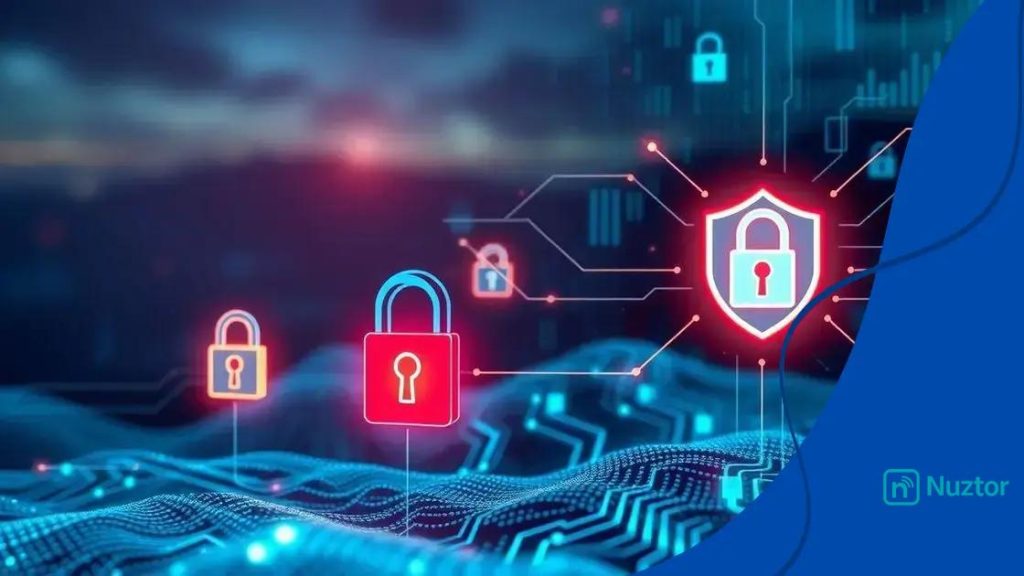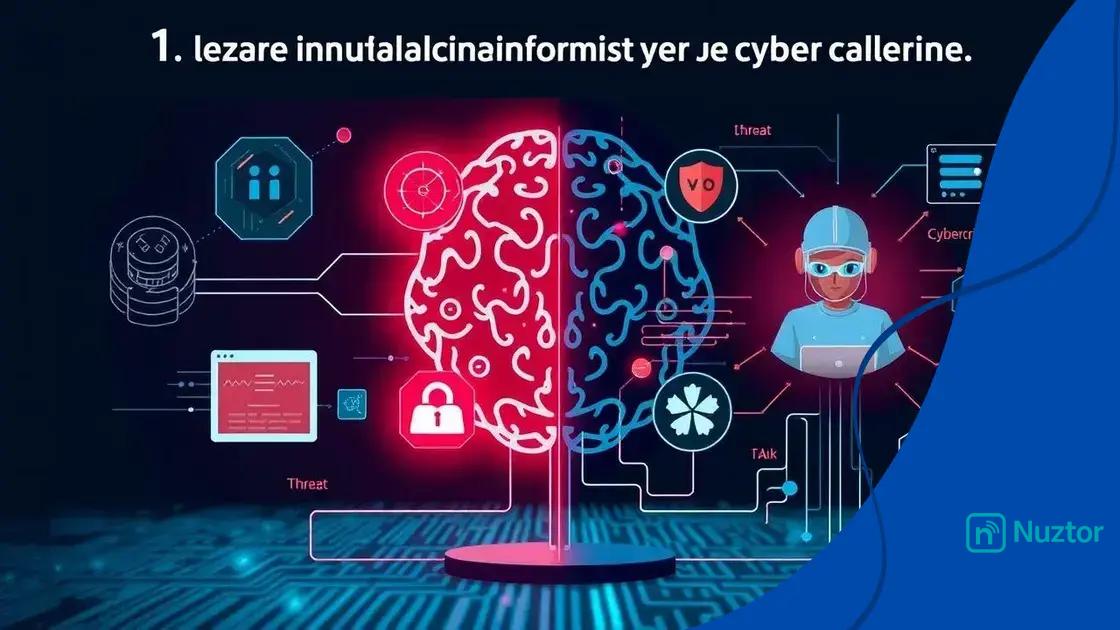Cybersecurity threats 2025: what to expect next

Preparing for cybersecurity threats involves employing best practices such as regular software updates, employee training, strong password policies, and creating robust incident response plans to effectively safeguard your organization.
Cybersecurity threats 2025 are on the horizon, and they’re becoming more complex. Are you ready to protect your data from the next wave of cyber risks? Let’s dive into what these threats could entail and how you can stay one step ahead.
Emerging trends in cybersecurity threats
As the digital landscape evolves, emerging trends in cybersecurity threats are shaping how organizations protect their data. Understanding these threats is vital for businesses striving to stay ahead in 2025.
Increased Ransomware Attacks
Ransomware continues to be a significant challenge. In 2025, we can expect more sophisticated methods that target companies of all sizes. Many cybercriminals now employ double extortion techniques, where they not only encrypt data but also threaten to leak it.
Supply Chain Vulnerabilities
Another prominent trend is the growing risk posed by supply chain vulnerabilities. As companies become more interconnected, a single breach can affect multiple entities. Therefore, it’s crucial for organizations to evaluate the security measures of their partners.
- Conduct regular security audits
- Implement strict access controls
- Monitor third-party compliance
Additionally, the rise of remote work has significantly changed the threat landscape. Attackers are exploiting weaknesses in home networks to gain unauthorized access. This shift calls for enhanced security practices at all levels.
AI and Machine Learning Threats
AI and machine learning are powerful tools for both cybersecurity and cybercriminals. As these technologies become more widely used, they will likely lead to new types of attacks. Companies must invest in AI-driven security solutions to counter these threats effectively.
With the landscape of cybersecurity threats rapidly changing, staying informed is essential. Businesses should adapt to these trends and continually update their security protocols to minimize risks. Embracing a proactive approach can make all the difference in mitigating potential attacks.
Being aware of emerging trends helps organizations strengthen their defenses. As the world becomes more digital, improving cybersecurity measures is not just an option; it’s a necessity.
Top risks for businesses in 2025
As we look towards the future, understanding the top risks for businesses in 2025 is crucial for developing effective strategies. These risks can impact any company, regardless of size or industry.
Cybersecurity Threats
First and foremost, cybersecurity threats remain a top concern. As technology advances, so do the tactics of cybercriminals. Companies can expect more sophisticated attacks targeting sensitive data.
Regulatory Changes
Another significant risk is the potential for regulatory changes that impact business operations. Governments are continually updating laws regarding data protection, labor, and the environment. Staying compliant can be challenging yet essential.
- Invest in compliance training
- Monitor changes in legislation
- Adapt policies accordingly
In addition to compliance, the threat of economic instability looms large. Market fluctuations can affect revenue and profitability. Businesses must have flexible strategies to adapt to changing economic conditions and maintain resilience.
Supply Chain Disruptions
Supply chain disruptions are increasingly common due to global events and logistic challenges. Having contingency plans in place is paramount. Companies should consider diversifying their suppliers to minimize risks.
Lastly, the push for sustainability can pose risks too. As consumers demand greener practices, businesses must find ways to incorporate sustainability without sacrificing profit margins. This shift requires innovation and understanding of new market trends.
In summary, being aware of the top risks for businesses in 2025 enables companies to prepare and strategize effectively. Adaptability and proactive measures can help navigate this evolving landscape successfully.
Impact of AI on cybersecurity threats

The impact of AI on cybersecurity threats is profound and multifaceted. As artificial intelligence technology advances, it both enhances security measures and poses new challenges. Understanding this balance is crucial for organizations looking to protect their assets.
AI in Threat Detection
One key area where AI is making a difference is in threat detection. By analyzing vast amounts of data quickly, AI can identify patterns and anomalies that may indicate a security breach. This proactive approach allows companies to respond to potential threats before they escalate.
Automated Response Systems
AI also enables automated response systems. When a threat is detected, AI can react almost instantly, mitigating damage. This speed is vital in the fast-paced digital environment where cyber attacks can happen in seconds.
- Real-time monitoring of network traffic
- Automated threat mitigation strategies
- Immediate alerts for suspicious activities
However, as AI tools improve, cybercriminals are adapting as well. They are using AI to conduct more sophisticated attacks. For instance, AI can help hackers personalize phishing attacks, making them harder to detect. This shift means organizations must continuously improve their defensive measures.
Bias and Ethical Concerns
Furthermore, the integration of AI raises ethical concerns. If algorithms are not designed with care, they can reflect biases, leading to false positives or missed threats. Companies need to ensure their AI systems are trained on diverse datasets to minimize these risks.
In conclusion, the impact of AI on cybersecurity threats is a double-edged sword. While it significantly enhances security and response times, it also presents new risks that must be managed carefully. Organizations need to stay informed and adapt continuously to protect their information effectively.
How to prepare for future cyber attacks
Knowing how to prepare for future cyber attacks is essential for every business. A proactive approach can help organizations mitigate risks and respond effectively when threats arise.
Conduct Regular Security Assessments
One effective way to prepare is by conducting regular security assessments. This practice helps identify vulnerabilities in your systems. Businesses should run penetration tests and vulnerability scans to find and fix security gaps.
Employee Training and Awareness
An informed workforce can significantly enhance security. Ongoing employee training is vital. Training should cover awareness of phishing attacks, safe browsing habits, and secure password practices.
- Organize regular workshops
- Implement simulated phishing tests
- Provide resources on cybersecurity best practices
Moreover, developing an incident response plan is crucial. This plan outlines steps your organization will take if a cyber attack occurs. Having an effective response strategy can limit damage and recovery time.
Invest in Advanced Security Technology
Investing in advanced security technologies is another essential step. Tools like AI-driven malware detection and intrusion prevention systems enhance your defense. These technologies can help detect suspicious activities in real-time.
Finally, maintaining regular software updates and patches is fundamental. Cybercriminals often exploit outdated software. Keeping your systems updated helps close security gaps and protects against known vulnerabilities.
By understanding how to prepare for future cyber attacks, businesses can create a robust security posture. Combining employee training, technology investments, and proactive measures is key to staying protected.
Best practices for enhancing security
Implementing the best practices for enhancing security is vital for protecting sensitive information and maintaining trust. Organizations must adopt strategies that not only address current threats but also anticipate future risks.
Regularly Update Software
One essential practice is regularly updating all software, including operating systems and applications. Cybercriminals frequently target outdated software to exploit vulnerabilities. By keeping systems up to date, you significantly reduce the risk of security breaches.
Use Strong Password Policies
Another critical measure is adopting strong password policies. Encourage employees to create complex passwords and change them frequently. Utilize password managers to help maintain security without compromising convenience.
- Implement multi-factor authentication (MFA)
- Educate employees about phishing attacks
- Limit access to sensitive data based on roles
Training employees about cybersecurity is equally important. Awareness can greatly reduce risks. Conducting regular training sessions helps employees recognize threats like phishing and social engineering.
Backup Data Regularly
A strong backup strategy is also a critical component. Make sure to back up data regularly and store it securely. In case of a ransomware attack or system failure, having a backup ensures your organization can recover quickly.
Lastly, create an incident response plan. This plan should outline steps to take in case of a security breach. Having a clear action plan allows for faster recovery and minimizes damage during an attack.
By following these best practices for enhancing security, organizations can create a robust defense against cyber threats. Being proactive and prepared is key to maintaining a secure environment.
FAQ – Frequently Asked Questions about Cybersecurity Preparedness
Why is it important to train employees on cybersecurity?
Training employees helps them recognize potential threats like phishing and improves overall security awareness within the organization.
What is multi-factor authentication, and why should I use it?
Multi-factor authentication adds an extra layer of security by requiring more than one form of verification before granting access to accounts, making it harder for attackers to gain unauthorized access.
How often should I update my software?
Software should be updated regularly, ideally as soon as updates are available, to protect against newly discovered vulnerabilities and enhance security features.
What should I include in an incident response plan?
An incident response plan should outline the steps to take during a security breach, including identification, containment, eradication, recovery, and communication strategies.